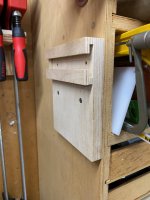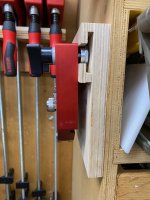Received the Woodpecker ThinRip Guide last Friday. This morning, I set it up, aligned it with my saw-blade and did some 1/16" test cuts. The strips were very consistent across their length and right on the mark.
It's also more substantial that I was expecting (a good thing) and has an imperial and metric scale.
I am pleased, I think it was worth the money (and I don't say that about all Woodpecker products). I have made strips using other methods earlier, this is an improvement, especially for making specific thicknesses.
Bob
It's also more substantial that I was expecting (a good thing) and has an imperial and metric scale.
I am pleased, I think it was worth the money (and I don't say that about all Woodpecker products). I have made strips using other methods earlier, this is an improvement, especially for making specific thicknesses.
Bob






